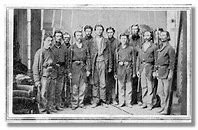Martyr or Murderer?

I stop and read historical markers. I’m the guy pulled off on the shoulder in the middle of nowhere, reading that bronze sign by the side of the road. You know the type. Frankly, if you are reading this blog, you probably are that type.
I get exposed to some interesting interpretations of history by doing so. Usually (but not always) these are created and erected by a state historical commission, who presumably (but again, not always) have also signed off on the text.
Let me give you one of my favorite examples: Champ Ferguson.
Samuel “Champ” Ferguson was born in 1821, in Clinton County, Kentucky. He was hung on October 20, 1865, for murder and bushwacking. Several books have been written about him. I find opinions to be sharply divided.
Here are two such historical markers dealing with Ferguson. As you might be able to tell, there is some difference of interpretation involved.


Even in wartime, there are limits to use of deadly force: civilians are off-limits; a man in uniform (but flying a flag-of-truce) is protected by convention; prisoners are not to be subjected to inhumane treatment…
Champ Ferguson operated in a region that sought to remove itself from the State of Tennessee (much like West Virginia removed itself from the Confederate State of Virginia.) And Ferguson, a Confederate guerrilla, took it upon himself to kill civilians he believed harbored Union sympathies.
Sort of like John Brown?
Thanks for sharing Dave. Hopefully these such markers remain in place. The fact they display different interpretations is even better, potentially opening a window for a reader or visitor to learn additional information from other resources and exercise critical thinking.
Critical thinking to form an educated opinion……. an unfortunate lost concept for many in our current day with all things historical related or otherwise.
This is one of the fun things to do when touring…stopping at every wayside marker.
I had ancestors from that region. One was Willis Scott Bledsoe, Champ’s prewar attorney & sometimes wartime commander. Others rode with Tinker Dave Beaty, and with Rufus Dowdy, against Champ. Tough times, fascinating & tragic tales.
The borderlands have always been the special refuges for rogues and adventurers of all types. I am reminded of the borderlands between England, Scotland and Wales.
Let’s not turn truth on its head. Calling this guy a martyr is like calling Mussolini a martyr because he made trains run on time. The fact is that Ferguson was a pathological killer who was tried for 53 murders, but insisted that he had actually killed more than 100. His defense was that he never killed anyone who didn’t want to kill him. What he didn’t say is that they had better reason to want to kill him than he had to want to kill them. He was notorious for killing helpless and wounded POW’s in cold blood, as he did most famously at Saltville, Virginia. He also killed civilian Union sympathizers in Eastern Tennessee, of whom there were many. His actions were so foul and so contrary to the rules of war that even Confederate regulars wanted no part of him. It was even said that he delighted in severing the heads of some of his victims and rolling them down hillsides. Confederates arrested and jailed him in February, 1865, but released him in April for lack of proof. Federal finished the job later in the year and Ferguson became one of only two Confederates executed for war crimes, the other being Henry Wirz for his alleged crimes at Andersonville Prison..
John, Please note that I am not suggesting that Ferguson was a martyr. I tend to lean much more towards the murderer side. His actions at Saltville were proof enough of that. I am interested in the way he is presented so differently on these two signs.
An intriguing fellow. I’m glad there are two versions. The truth must be in there somewhere.
I’m with you in terms of pulling over to read obscure historical markers! 🙂 Thanks for posting.
–Chris Barry
Thanks, Dave, for the clarification.
0.0 …. Wooooooow… That can get confusing if you don’t know history. I can imagine a young person reading it and forming their first opinion of the man, then holding onto that ideal years later and arguing with anyone else who says differently. I guess that’s how all the problems start.